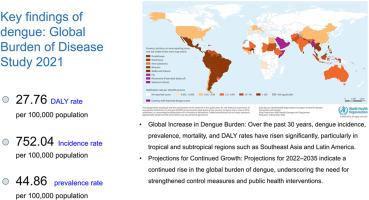Global, regional, and national burden of dengue, 1990–2021: Findings from the global burden of disease study 2021
引用次数: 0
Abstract
Background
Dengue is an acute viral infectious disease caused by the dengue virus and transmitted through mosquitoes. Although numerous studies have examined the global burden of dengue, comprehensive and systematic global analyses remain limited. This study uses data from the Global Burden of Disease (GBD) Study 2021 to systematically analyze the global epidemiological trends and disease burden of dengue from 1990 to 2021.
Methods
This study utilized data from the GBD Study 2021 Study to analyze trends in the incidence, prevalence, mortality, and disability-adjusted life years (DALYs) of dengue across 204 countries and territories, stratified by age, sex, and Socio-demographic Index (SDI) levels. In addition, a Bayesian age-period-cohort model was employed to predict the future burden of dengue. The average annual percent change (AAPC) was used to describe the overall trend in rates or counts of indicators between 1990 and 2021.
Results
In 2021, the global ASIR of dengue was 752.04 per 100,000 population (95 % UI: 196.33–1363.35), and ASMR was 0.38 per 100,000 population (95 % UI: 0.23–0.51). From 1990 to 2021, both the ASIR (AAPC = 7.89, 95 % CI: 7.89–8.91) and ASMR (AAPC = 0.01, 95 % CI: 0.00–0.01) showed an increasing trend. Adolescents under 14 years had the highest ASIR, age-standardized prevalence rate (ASPR), and age-standardized disability-adjusted life years (DALYs) for dengue. By 2035, the projected ASIR of dengue is 862.23 per 100,000 population (95 % CI: 627.84–1096.62 per 100,000 population), the ASPR is 51.60 per 100,000 population (95 % CI: 37.70–65.50 per 100,000 population), and the ASMR is 0.43 per 100,000 population (95 % CI: 0.29–0.56 per 100,000 population). The ASIR, ASPR, ASMR, and age-standardized DALYs for dengue are expected to continue rising in the next 10 years.
Conclusion
The global burden of dengue is projected to continue rising in the coming years, underscoring the urgent need for comprehensive control measures, including enhanced vector control, public education, vaccination, and drug development. These findings provide crucial scientific evidence for the formulation of effective public health strategies and interventions aimed at reducing the global threat posed by dengue.

1990-2021 年全球、地区和国家登革热负担:2021 年全球疾病负担研究结果
背景登革热是一种由登革热病毒引起并通过蚊子传播的急性病毒性传染病。尽管已有许多研究对登革热的全球负担进行了调查,但全面、系统的全球分析仍然有限。本研究利用《2021 年全球疾病负担研究》(GBD)的数据,系统分析了 1990 年至 2021 年登革热的全球流行趋势和疾病负担。本研究利用《2021 年全球疾病负担研究》的数据,分析了 204 个国家和地区的登革热发病率、流行率、死亡率和残疾调整生命年(DALYs)趋势,并按年龄、性别和社会人口指数(SDI)水平进行了分层。此外,还采用了贝叶斯年龄-时期-队列模型来预测登革热的未来负担。结果2021年,全球登革热ASIR为每10万人752.04例(95 % UI:196.33-1363.35),ASMR为每10万人0.38例(95 % UI:0.23-0.51)。从 1990 年到 2021 年,ASIR(AAPC = 7.89,95 % CI:7.89-8.91)和 ASMR(AAPC = 0.01,95 % CI:0.00-0.01)均呈上升趋势。14 岁以下青少年的登革热 ASIR、年龄标准化患病率 (ASPR) 和年龄标准化残疾调整生命年 (DALYs) 最高。预计到 2035 年,登革热的 ASIR 为每 10 万人 862.23 例(95 % CI:每 10 万人 627.84-1096.62 例),ASPR 为每 10 万人 51.60 例(95 % CI:每 10 万人 37.70-65.50 例),ASMR 为每 10 万人 0.43 例(95 % CI:每 10 万人 0.29-0.56 例)。预计未来 10 年登革热的 ASIR、ASPR、ASMR 和年龄标准化残疾调整寿命年数将继续上升。这些研究结果为制定有效的公共卫生战略和干预措施提供了重要的科学证据,旨在减少登革热对全球造成的威胁。
本文章由计算机程序翻译,如有差异,请以英文原文为准。
求助全文
约1分钟内获得全文
求助全文

 求助内容:
求助内容: 应助结果提醒方式:
应助结果提醒方式:


